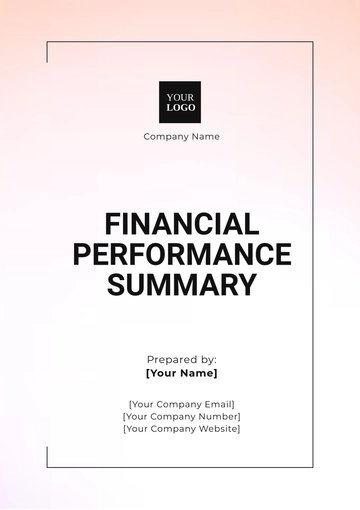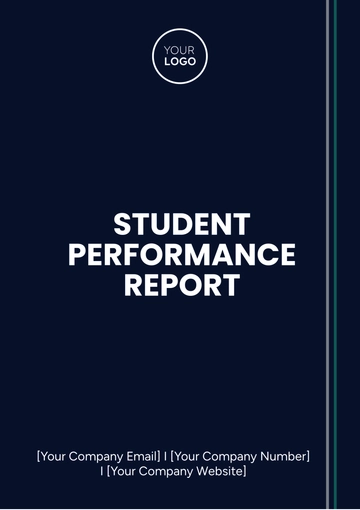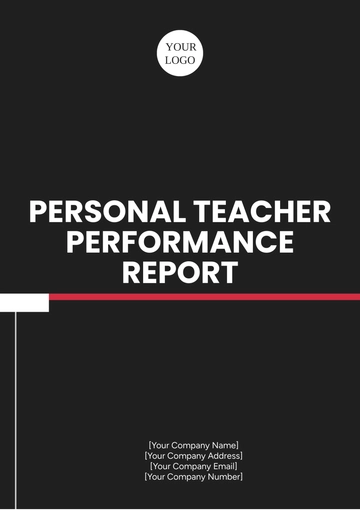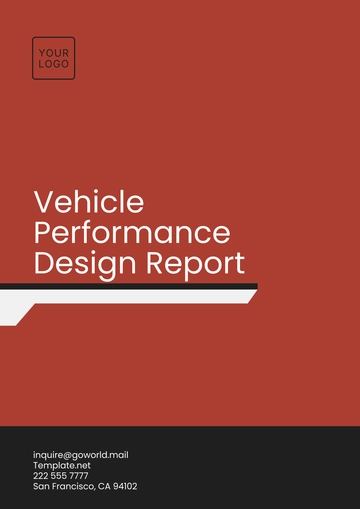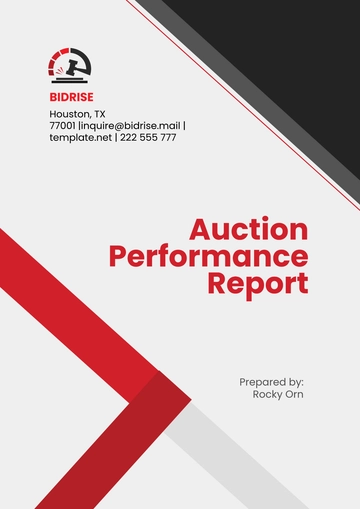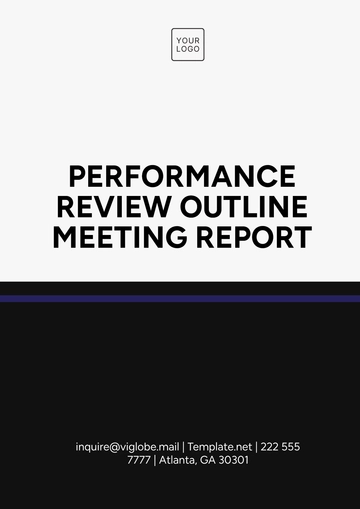Free Blank Car Wash Performance Report

I. Executive Summary
A. Overview
The purpose of this report is to provide a comprehensive analysis of the performance of [Your Company Name]'s car wash services over the past quarter. This report includes detailed metrics on service efficiency, customer satisfaction, financial performance, and operational improvements. The data presented will help in understanding current performance levels and identifying areas for potential enhancement.
B. Key Findings
Service Efficiency: The average car wash cycle time has been reduced by 10% compared to the previous quarter. This reduction is primarily attributed to the implementation of state-of-the-art automated systems that streamline the washing and drying process. Improved workflow management and staff training have also contributed significantly to enhancing service efficiency.
Customer Satisfaction: Customer satisfaction ratings have increased by 5%, with notable improvements in the speed and quality of service. Feedback from customer surveys highlights that customers appreciate the quicker turnaround times and the meticulous attention to detail in cleaning their vehicles. The friendliness and professionalism of the staff have been consistently mentioned as positive aspects of the customer experience.
Financial Performance: Revenue from car wash services has grown by 15%, reaching a total of $300,000 for the quarter. This growth can be attributed to both an increase in customer visits and a rise in the average spend per customer, particularly on premium services such as waxing and detailing. The strategic pricing adjustments and effective marketing campaigns have also played a crucial role in driving revenue growth.
Operational Improvements: Several operational enhancements have been implemented to streamline processes and reduce costs. Technological upgrades, including the adoption of automated systems and advanced customer management software, have not only improved service delivery but also optimized resource utilization. Staff training programs have focused on enhancing technical skills and customer service, resulting in higher productivity and lower error rates.
C. Recommendations
Continued Optimization: Continue to optimize car wash cycle times by fine-tuning the automated systems and further streamlining workflow processes. Consider leveraging predictive maintenance techniques to minimize equipment downtime and ensure consistent service delivery.
Investment in Staff: Invest in additional training for staff to maintain high levels of customer satisfaction. Implement ongoing training programs that focus on both technical skills and soft skills, such as effective communication and conflict resolution.
Marketing Strategies: Explore new marketing strategies to attract more customers to premium services. Consider partnerships with local businesses or community events to increase brand visibility and attract a broader customer base. Utilize digital marketing channels effectively to target specific customer segments and promote seasonal offers.
Technological Upgrades: Implement further technological upgrades to streamline operations and reduce costs. Evaluate the feasibility of integrating AI-powered solutions for predictive analytics or enhancing the customer experience through personalized service recommendations. Invest in sustainable technologies that align with environmental goals and customer expectations.
II. Service Efficiency
A. Cycle Time Analysis
Average Cycle Time: The average car wash cycle time for this quarter was 15 minutes, compared to 16.5 minutes in the previous quarter. This improvement is a direct result of the recent investment in automated washing and drying systems. These systems have significantly reduced manual intervention and allowed for a more efficient workflow, thereby decreasing the overall time required per vehicle.
Cycle Time Distribution: Analysis of cycle time distribution reveals that 70% of the car washes were completed within 12-18 minutes. This indicates a consistent and reliable service delivery within the expected timeframe for the majority of customers. Approximately 20% of the washes were completed in less than 12 minutes, demonstrating the efficiency gains achieved through automated processes and optimized operational protocols.
Factors Impacting Cycle Time: Factors that occasionally extended cycle times beyond the average included complex cleaning requirements for heavily soiled vehicles or occasional technical issues with equipment. However, proactive maintenance schedules and real-time monitoring systems have minimized these occurrences, ensuring smoother operations during peak hours.
B. Throughput
Daily Throughput: The average number of cars washed per day increased from 150 to 165, reflecting a 10% growth in throughput capacity. Peak days saw throughput numbers rise to 200 cars, particularly during weekends and promotional events. This increase can be attributed to improved operational efficiency and effective scheduling of staff shifts to meet fluctuating demand.
Hourly Throughput: Analysis of hourly throughput patterns indicates that during peak hours (10 AM - 2 PM), the car wash processed an average of 20 cars per hour. This peak throughput is strategically managed through optimized staffing levels and efficient use of automated systems to maintain service speed and quality. Off-peak hours, typically observed early morning or late afternoon, saw an average of 10 cars per hour, presenting opportunities for further capacity utilization through targeted promotional campaigns or service bundling offers.
III. Customer Satisfaction
A. Survey Results
Overall Satisfaction: Customer satisfaction ratings for this quarter improved to 85%, up from 80% in the previous quarter. This positive shift is indicative of the company's commitment to enhancing service quality and customer experience. Key drivers of satisfaction include the speed of service, quality of cleaning results, and the professionalism of staff interactions.
Net Promoter Score (NPS): The Net Promoter Score increased to 50, compared to 45 in the previous quarter. This metric reflects the likelihood of customers recommending [Your Company Name]'s car wash services to others. The improved NPS underscores the effectiveness of ongoing customer feedback initiatives and the company's proactive approach to addressing customer concerns and preferences.
B. Feedback and Testimonials
Positive Feedback: Customer testimonials consistently highlight the convenience, efficiency, and high-quality results of [Your Company Name]'s car wash services. Customers appreciate the attention to detail in cleaning, including the use of premium cleaning products and the careful handling of vehicles. Positive feedback also emphasizes the cleanliness and welcoming atmosphere of the facility, contributing to an overall positive customer perception.
Areas for Improvement: While overall satisfaction levels are high, specific areas for improvement include enhancing the waiting area amenities to provide a more comfortable experience for customers during peak periods. Additionally, some customers have suggested expanding service options or introducing loyalty rewards for frequent visitors to further enhance customer retention and satisfaction levels.
IV. Financial Performance
A. Revenue Analysis
Total Revenue: Total revenue generated from car wash services during the quarter amounted to $300,000, marking a 15% increase from the previous quarter's revenue of $260,000. This growth trajectory can be attributed to a combination of increased customer traffic, higher average ticket prices, and effective sales promotions targeting premium services.
Revenue Breakdown: Analysis of revenue sources reveals that standard car wash services accounted for 60% of total revenue, while premium services such as waxing and detailing contributed 30%. Additional sales, including car accessories and maintenance products, accounted for the remaining 10% of revenue. This diversification in revenue streams underscores the effectiveness of the company's service portfolio in meeting diverse customer preferences and expectations.
B. Cost Analysis
Total Costs: Total operational costs associated with car wash services for the quarter amounted to $180,000, resulting in a net profit of $120,000. Major cost components include labor wages, utilities (water and electricity), maintenance of equipment, and procurement of cleaning supplies and consumables. Effective cost management strategies, including bulk purchasing agreements and energy-efficient technologies, have contributed to maintaining healthy profit margins despite revenue growth.
Cost Efficiency Initiatives: Efforts to enhance cost efficiency include the implementation of energy-saving measures and the adoption of eco-friendly cleaning products that reduce environmental impact while optimizing operational expenses. Continuous monitoring of cost-per-wash metrics and periodic financial reviews ensure alignment with budgetary targets and sustainability objectives.
V. Operational Improvements
A. Technological Upgrades
Automated Systems: The recent deployment of automated washing and drying systems has been pivotal in enhancing operational efficiency and customer satisfaction. These systems utilize advanced sensor technologies and robotics to streamline the car wash process, resulting in consistent cleaning quality and reduced cycle times. Real-time data analytics from these systems also enable proactive maintenance scheduling and performance optimization.
Customer Management Software: Implementation of a new customer management software platform has revolutionized service delivery by offering seamless appointment scheduling, personalized service recommendations, and integrated feedback mechanisms. The software's intuitive interface and mobile accessibility have improved customer engagement and retention rates, allowing [Your Company Name] to build stronger relationships with its clientele.
B. Staff Training and Development
Training Programs: Robust training programs have been instrumental in empowering staff members with the skills and knowledge necessary to deliver exceptional service. Training modules encompass technical proficiency in operating automated equipment, customer service best practices, and safety protocols. Continuous professional development initiatives, including cross-training opportunities and leadership workshops, foster a culture of learning and innovation among the workforce.
Staff Performance Metrics: Performance metrics such as service speed, accuracy, and customer interaction quality are regularly monitored and evaluated to identify areas for improvement. Real-time feedback mechanisms and performance appraisals ensure that staff members receive constructive guidance and recognition for their contributions. High employee satisfaction levels and low turnover rates underscore the success of [Your Company Name]'s commitment to staff training and development.
VI. Customer Demographics and Behavior
A. Demographic Analysis
Age and Gender Distribution: Analysis of customer demographics indicates a diverse customer base, with the majority falling within the 25-45 age bracket. There is a fairly even distribution between male and female customers, reflecting broad appeal and accessibility of [Your Company Name]'s car wash services. Notably, there has been a growing influx of younger customers (18-25 years old), underscoring the company's ability to cater to varying generational preferences.
Location and Frequency: Geospatial analysis reveals that most customers reside within a 10-mile radius of the car wash facility, emphasizing the importance of localized marketing strategies and community engagement initiatives. Approximately 60% of customers visit the car wash at least once a month, with 20% frequenting the facility on a weekly basis. Understanding these patterns allows [Your Company Name] to tailor promotional efforts and service offerings to enhance customer retention and satisfaction.
B. Behavioral Trends
Service Preferences: Customer preferences lean towards standard car wash services, which constitute the majority of service requests. However, there is a noticeable trend towards increased demand for premium services such as waxing, detailing, and interior cleaning. This shift reflects evolving consumer preferences for comprehensive car care solutions and highlights opportunities for revenue growth through service diversification and personalized upselling strategies.
Feedback and Suggestions: Customer feedback indicates a strong preference for convenient service options, including online booking and express checkout capabilities. Enhancing these digital service channels and integrating seamless payment solutions aligns with customer expectations for efficiency and convenience. Moreover, initiatives to introduce loyalty programs and targeted promotional offers have been well-received, contributing to enhanced customer loyalty and repeat business.
VII. Environmental Impact
A. Water Usage
Total Water Consumption: The company's commitment to environmental sustainability is evidenced by a 5% reduction in total water consumption, totaling 50,000 gallons for the quarter. This reduction is attributed to the implementation of water-saving technologies such as high-efficiency nozzles and automated shut-off systems. Continuous monitoring and adjustment of water recycling processes further contribute to minimizing environmental footprint while ensuring operational efficiency.
Efficiency Measures: Ongoing efforts to optimize water usage include routine maintenance of filtration systems and regular calibration of water treatment equipment. These proactive measures not only preserve natural resources but also mitigate operational costs associated with water procurement and wastewater management. [Your Company Name] remains dedicated to exploring innovative solutions that enhance water conservation efforts without compromising service quality.
B. Chemical Usage
Eco-friendly Products: Transitioning to eco-friendly cleaning products has been pivotal in reducing the company's environmental impact while meeting stringent regulatory standards. These biodegradable products are formulated to deliver effective cleaning results while minimizing harmful emissions and residues. Customer feedback regarding the use of eco-friendly products has been overwhelmingly positive, reflecting growing consumer preference for sustainable business practices.
Chemical Consumption: A 10% reduction in chemical consumption has been achieved through the implementation of precise dosing technologies and improved inventory management practices. By accurately measuring and controlling chemical usage, [Your Company Name] not only enhances operational efficiency but also upholds its commitment to environmental stewardship. Future initiatives will focus on expanding the range of eco-friendly products and optimizing their application to further reduce environmental footprint across all operational facets.
VIII. Marketing and Promotions
A. Campaign Effectiveness
Digital Marketing: Strategic investments in digital marketing campaigns have yielded significant returns, with targeted social media advertisements generating over 20,000 clicks and 1,000 conversions. Search engine marketing initiatives have also driven traffic to [Your Company Name]'s website, resulting in increased online bookings and service inquiries. These digital channels continue to be instrumental in enhancing brand visibility and attracting new customer segments.
In-store Promotions: In-store promotions, including loyalty programs and referral discounts, have proven effective in fostering customer loyalty and encouraging repeat business. The introduction of a tiered loyalty rewards program has incentivized frequent visits and higher spending among existing customers. Collaborative promotions with local businesses and community events further reinforce [Your Company Name]'s commitment to engaging with the local community and driving mutual growth.
B. Customer Acquisition
New Customers: A targeted customer acquisition strategy has contributed to a 10% increase in new customer acquisition rates during the quarter. Key tactics include personalized email marketing campaigns, promotional offers for first-time visitors, and strategic partnerships with complementary service providers. Analyzing customer acquisition cost metrics allows [Your Company Name] to optimize marketing spend and allocate resources effectively across various acquisition channels.
Retention Strategies: Robust retention strategies, such as proactive customer engagement through personalized communications and exclusive loyalty rewards, have bolstered customer retention rates. Real-time feedback collection mechanisms and responsive customer service initiatives ensure prompt resolution of issues and continuous improvement in service delivery. By nurturing long-term customer relationships, [Your Company Name] aims to sustain growth and strengthen its market position amidst evolving industry dynamics.
IX. Future Plans and Goals
A. Expansion Plans
New Locations: [Your Company Name] is poised to expand its footprint with the opening of two new car wash locations in high-traffic areas within the next quarter. These new facilities will feature state-of-the-art equipment and enhanced customer amenities, catering to growing demand for premium car care services. Strategic site selection and market analysis guide expansion efforts to capitalize on untapped market potential and broaden geographic reach.
Service Diversification: In response to shifting consumer preferences and emerging industry trends, [Your Company Name] plans to introduce new service offerings, including mobile car wash units and eco-friendly detailing solutions. These innovations aim to meet evolving customer expectations for convenience, sustainability, and superior service quality. Continuous research and development initiatives ensure that [Your Company Name] remains at the forefront of industry innovation and customer satisfaction.
B. Technological Advancements
Innovative Solutions: Continued investment in innovative technologies, such as AI-powered wash systems and advanced customer analytics tools, will drive operational efficiency and enhance service personalization. These technologies enable predictive maintenance, real-time performance monitoring, and data-driven decision-making, empowering [Your Company Name] to deliver exceptional customer experiences. Seamless integration of smart technologies across all touchpoints reinforces the company's commitment to digital transformation and operational excellence.
Sustainability Initiatives: Strengthening sustainability initiatives remains a cornerstone of [Your Company Name]'s corporate strategy. Future initiatives will focus on further reducing environmental footprint through enhanced energy efficiency measures and expanded use of renewable resources. Collaborations with eco-friendly product suppliers and community environmental programs underscore [Your Company Name]'s dedication to environmental stewardship and corporate social responsibility.
X. Conclusion
A. Summary of Performance
The performance of [Your Company Name]'s car wash services this quarter has been marked by significant achievements in service efficiency, customer satisfaction, financial growth, and operational excellence. These accomplishments underscore the company's commitment to delivering superior car care solutions while fostering sustainable business practices. By leveraging innovative technologies, investing in employee development, and engaging with the community, [Your Company Name] continues to set industry benchmarks and exceed customer expectations.
B. Next Steps
Moving forward, [Your Company Name] will continue to prioritize customer-centric initiatives, expand its service offerings, and explore new market opportunities. Strategic expansion into new locations, coupled with advancements in technology and sustainability, will drive future growth and reinforce [Your Company Name]'s position as a leader in the car wash industry. Continuous monitoring of industry trends and customer feedback will inform strategic decision-making and ensure alignment with evolving consumer preferences.
C. Acknowledgements
The success of this quarter's performance is a testament to the dedication and hard work of the entire team at [Your Company Name]. Their unwavering commitment to excellence, coupled with their passion for delivering exceptional service, has been instrumental in achieving these outstanding results. [Your Company Name] extends its sincere appreciation to its valued customers, whose trust and loyalty continue to inspire the company's pursuit of excellence and innovation.
Appendix A: Detailed Metrics and Data
1. Service Efficiency Data
Metric | Current Quarter | Previous Quarter |
|---|---|---|
Average Cycle Time | 15 minutes | 16.5 minutes |
Daily Throughput | 165 cars | 150 cars |
Peak Hour Throughput | 20 cars/hour | 18 cars/hour |
2. Customer Satisfaction Data
Metric | Current Quarter | Previous Quarter |
|---|---|---|
Overall Satisfaction Rate | 85% | 80% |
Net Promoter Score (NPS) | 50 | 45 |
3. Financial Performance Data
Metric | Current Quarter | Previous Quarter |
|---|---|---|
Total Revenue | $300,000 | $260,000 |
Revenue from Standard Washes | $180,000 | $156,000 |
Revenue from Premium Services | $90,000 | $78,000 |
4. Environmental Impact Data
Metric | Current Quarter | Previous Quarter |
|---|---|---|
Total Water Consumption | 50,000 gallons | 52,500 gallons |
Chemical Usage Reduction | 10% | N/A |
Appendix B: Customer Feedback
"The car wash service was incredibly fast and thorough. I'm very impressed with the quality and will definitely be back."
"Staff were friendly and professional. The waiting area could use some more amenities, but overall, a great experience."
"I love the new eco-friendly products being used. It's great to see the company taking steps to reduce its environmental impact."
Appendix C: Marketing Campaign Details
Digital Marketing Campaign
Social Media Ads: $10,000 spent, 20,000 clicks, 1,000 conversions.
Search Engine Marketing: $5,000 spent, 10,000 clicks, 500 conversions.
In-store Promotions
Loyalty Program: 500 new sign-ups, 300 repeat visits.
Referral Discount: 200 new customers acquired through referrals.
- 100% Customizable, free editor
- Access 1 Million+ Templates, photo’s & graphics
- Download or share as a template
- Click and replace photos, graphics, text, backgrounds
- Resize, crop, AI write & more
- Access advanced editor
Track performance metrics with the Blank Car Wash Performance Report Template on Template.net. It's customizable and editable, designed for comprehensive reporting. Utilize our Ai Editor Tool to document key performance indicators, optimizing operations and improving service quality in your car wash business.
You may also like
- Sales Report
- Daily Report
- Project Report
- Business Report
- Weekly Report
- Incident Report
- Annual Report
- Report Layout
- Report Design
- Progress Report
- Marketing Report
- Company Report
- Monthly Report
- Audit Report
- Status Report
- School Report
- Reports Hr
- Management Report
- Project Status Report
- Handover Report
- Health And Safety Report
- Restaurant Report
- Construction Report
- Research Report
- Evaluation Report
- Investigation Report
- Employee Report
- Advertising Report
- Weekly Status Report
- Project Management Report
- Finance Report
- Service Report
- Technical Report
- Meeting Report
- Quarterly Report
- Inspection Report
- Medical Report
- Test Report
- Summary Report
- Inventory Report
- Valuation Report
- Operations Report
- Payroll Report
- Training Report
- Job Report
- Case Report
- Performance Report
- Board Report
- Internal Audit Report
- Student Report
- Monthly Management Report
- Small Business Report
- Accident Report
- Call Center Report
- Activity Report
- IT and Software Report
- Internship Report
- Visit Report
- Product Report
- Book Report
- Property Report
- Recruitment Report
- University Report
- Event Report
- SEO Report
- Conference Report
- Narrative Report
- Nursing Home Report
- Preschool Report
- Call Report
- Customer Report
- Employee Incident Report
- Accomplishment Report
- Social Media Report
- Work From Home Report
- Security Report
- Damage Report
- Quality Report
- Internal Report
- Nurse Report
- Real Estate Report
- Hotel Report
- Equipment Report
- Credit Report
- Field Report
- Non Profit Report
- Maintenance Report
- News Report
- Survey Report
- Executive Report
- Law Firm Report
- Advertising Agency Report
- Interior Design Report
- Travel Agency Report
- Stock Report
- Salon Report
- Bug Report
- Workplace Report
- Action Report
- Investor Report
- Cleaning Services Report
- Consulting Report
- Freelancer Report
- Site Visit Report
- Trip Report
- Classroom Observation Report
- Vehicle Report
- Final Report
- Software Report






